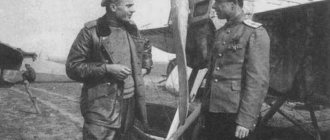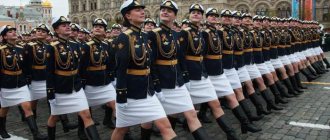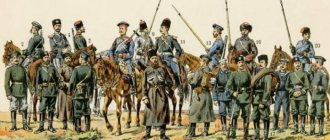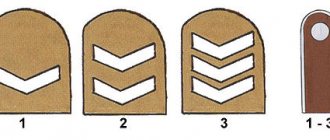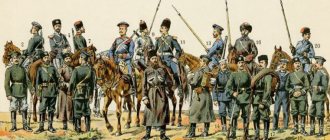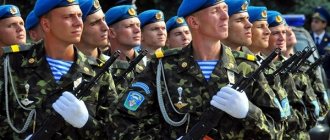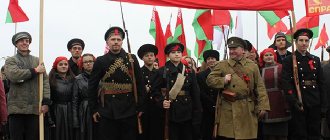The history of military uniforms does not go back to ancient times, as one might think at first. What we are accustomed to consider as a form appeared only in the 17th century, with the beginning of military reforms in Europe. However, the first examples of military uniforms can be seen already in ancient Greece.
Of course, the uniform army suit is a relatively recent invention, but a certain military style of clothing has always existed. You couldn’t just pick up a sword or bow and become a soldier in the eyes of your opponents. Let's take a short tour into the history of clothing of ancient warriors.
FRANCE
France is famous for its exquisite cuisine and culinary skills. This is probably why the army in full dress looks more like troops of cooks. The most interesting thing is that such a strange beret is used by some types of troops in battle.
Modern military camouflage of the armed forces of the world
For a very long period in military history, no one knew, heard or wanted to think about not only military camouflage , but even about khaki uniforms. The military uniform then had only one task - identification on the battlefield. The battles took place at close ranges, and more often hand-to-hand, and the ability to immediately determine whether you were an ally or an enemy was a priority. Therefore, the soldiers’ uniforms were full of bright colors - red, blue, yellow.
With the development of firearms, the battle distance began to increase, and gradually the military leaders came up with an interesting idea - why not camouflage their own forces on the battlefield, making the task more difficult for enemy shooters? That's when camouflage was invented - a military uniform that hides a soldier from the eyes of the enemy. The word “camouflage” refers not only to a multi-colored spotted modern pattern, but also to plain khaki-colored clothing.
According to the chronicles, camouflage was used for the first time in history during the Anglo-Boer War in 1899-1902, when the Boers used colors in their equipment that allowed them to blend into the terrain, while the British in bright red uniforms were almost like targets in a shooting range at the fair. After which the command of the British forces made a historic decision and dressed the soldiers in khaki uniforms.
After which, certain armies of the world began to use protective colors to outfit their soldiers, and then special camouflage patterns (patterns), which hid the soldiers much better than plain clothes. For example, in the Wehrmacht armed forces alone there were more than 30 different camouflage patterns, suitable for all types of terrain and seasons.
In addition to military camouflages (called standard, or army - they were officially adopted into service), by now a great variety of commercial camouflage colors and patterns have appeared, which are produced by private companies for professional shooters, hunters, PMC employees and special forces. Next we will talk about military camouflage.
Conventionally, all military camouflage can be divided into 5 main groups:
- Forest (Europe, North America, Russia).
- Desert (North Africa, partly Asia, Middle East).
- Jungle (South America, southeast Asia).
- Winter (in conditions of snow);
- Bush (created taking into account the characteristics of the territory of South Africa - this group includes only a few types of camouflage).
That is, all camouflage colors existing in the armed forces can be attributed to some of these groups. Some add separate categories “City” and “Miscellaneous” there. The first option is for action in an urban landscape, and the second is for describing camouflages that work on a different principle than traditional camouflage colors.
And then we will go through the modern military camouflages of countries that were, or are, ahead of the rest in matters of combat operations, military affairs and equipping their soldiers. So…
The content of the article
USSR camouflage
Almost all known uniforms of the USSR were, to one degree or another, copied from the Wehrmacht’s armed models. Of course, there are our own developments, but why reinvent the wheel if a ready-made camouflage pattern has shown its effectiveness in specific conditions. And sometimes it justified itself.
"Amoeba"
The camouflage pattern was developed in 1935 and had several options for different conditions.
"Deciduous Forest"
It was borrowed from the Wehrmacht army in 1942 and only slightly modified. There were two types of this camouflage - for summer and autumn forest.
"Palm"
Also developed in 1944 based on German camouflage patterns. " Palma " was produced in four versions, according to the seasons - spring, summer, autumn and winter.
"Birch"
The “Birch” camouflage is also known as “ sunny bunny ” and “ silver leaf ”. Developed in 1957. The basis, as in previous versions, is taken from some highly effective camouflages used in Nazi Germany. Green background, white deforming pattern (closest to modern “Digital Flora”). In 1980 it was modified for deciduous forests of the middle zone (bottom photo). It is considered somewhat outdated, but the “Beryozka” overalls are still used by airborne troops (due to its convenience, but after a little modification), and is also extremely popular among hunters, fishermen and various outdoor enthusiasts, incl. airsoft players.
"Butane"
Or " Dubok ". Developed in 1984 for border troops as a replacement for the outdated Beryozka. It has been used by the Ukrainian armed forces for a long time; now they are trying to replace camouflage with something more modern and effective. Still, a lot has changed since the 80s, and “digital” is gradually replacing all other types.
Camouflage of modern Russian Armed Forces
Here everything is a little more prosaic. If the first camouflage uniforms of the Russian Armed Forces were inherited from the USSR, which, in turn, was inspired by the camouflage patterns of the army of Nazi Germany, then subsequent developments are purely their own, but not particularly original. Although the Russian protective uniform performs the task of camouflage in typical middle zone terrain perfectly.
"Partisan"
It has the unofficial name " frog ". Modern camouflage, simply copied at one time from the German “ Eichentarn ”.
VSR-93 "Vertical"
Used from 1993 to this day. Mainly in the post-Soviet space. Classic camouflage, various spots of green and brown shades.
VSR-98 "Flora"
Or " Cabbage " or " Watermelon ". Developed, as the name implies, in 1998, for some time it was the main camouflage in service with the Russian Army, but has recently been considered obsolete.
Digital flora
Digital flora is one of the latest developments of the Russian Armed Forces, and is currently being tested. The camouflage properties are excellent, the silhouette breaks up perfectly.
Wehrmacht and Bundeswehr camouflage
In general, the Germans at one time were ahead of everyone else in terms of camouflages - they came up with almost 40 different options - and almost all of them were very effective for their conditions. We will consider only the most famous ones.
WH splintentarn
It is considered almost the first German camouflage uniform, invented back in 1931. Spots with clear edges, different colors, “hatching”. For its time it was very effective, but then gave way to more advanced options.
Eichentarn
1942 This option was supplied in several colors. A distinctive feature is the presence of small but numerous spots. It was used for quite a long time, including in the armed forces of East Germany.
Flectarn
1985 The development of the idea of “eichentarna”, which is noticeable in numerous small spots. Flektarn is available in several versions and is used in the Bundeswehr army to this day.
Tropentarn
An analogue of "flektarn" for deserts, developed in the 1990s.
US Camouflage
At one time, the United States was not particularly far behind Germany in the development of camouflage. Currently, the lion's share of companies designing and selling commercial uniforms and camouflage patterns to the world market are located in the United States. However, we are only talking about the “official” military camouflage, so further on we will talk about it.
Khaki
The same legendary " Khaki ". Officially, the very first widespread camouflage pattern. The US Armed Forces used " Khaki " in World War II. For combat operations in arid areas and in the desert, this is just the thing. Something similar was used by both the African units of the Third Reich and the US armed forces. It is still the official “military color” in some countries.
Olive
A further development of " khaki ", adapted to jungle conditions. Cheap and cheerful. Used by the US in Korea and during the Vietnam War. And the Cuban partisans also really liked it. They say that Fidel Castro almost never parted with his Olive uniform .
Woodland
A well-deserved classic. Woodland was developed in the eighties and was available in several color options, depending on the specific conditions of the area. The standard is as in the photo, in the version for plains and forests there were more green spots, in the “mountain” version there were brown spots. Well, the fourth option was generally supposed to mask in the optical and infrared range. At the moment, this military camouflage is not used by the US Army, but there are about a dozen uniforms based on Woodland that are successfully used.
3-color Desert / 6-color Desert
Developed based on Woodland, for desert operations of US Army soldiers. 3-color Desert is a pattern of spots of three colors - two shades of green and brown. 6-color Desert - a more complex pattern of spots of as many as six colors.
MARPAT
One of the first successful examples of digital camouflage. In fact, the same “woodland”, only converted into pixels. It was developed to replace the Woodland and was used for a long time by the US Marines ( MARPAT is an abbreviation for Marine Pattern), including for combat in urban environments, since one of the colors was perfect for this purpose. There were three colors in total: standard - Digital Woodland , for deserts and arid conditions - Digital Desert , for urban conditions - Digital Urban .
ACUPAT/UCP
Developed for US Army forces operating on land, based on MARPAT. The pixels have become larger, the color gamut has become even less contrasting. ACUPAT - unofficial name, means Army Combat Uniform Pattern . Officially, this military camouflage is called UCP - Universal Camouflage Pattern . Also known as Digicam (Digital Camouflage).
Multicam
The same “Woodland”, only cooler. Actually, it was developed as a modern replacement, but for certain reasons it did not deserve recognition in the army, and the US Armed Forces are practically not used. However, the Multicam camouflage is more than decent - the spots are round, numerous and varied, the pixels are not visible, so the blurring of the silhouette occurs precisely due to the complexity of perception. Therefore, in the commercial sphere, it is the favorite uniform of anyone, including the special forces of the TsSN FSB “Alpha”.
Kryptek 3D Camouflage
We simply couldn’t help but talk about this promising 3D camouflage pattern . Kryptek has proposed a design concept that uses the latest developments in camouflage and optical deception . The new uniform is currently undergoing field testing and may soon be adopted by the US Army.
Military camouflage of other countries
Next, we will tell you about the most interesting (we do not take into account obvious copies) current military camouflage from other countries of the world. Still, there are no particularly large-scale and popular developments of camouflage patterns, such as in the USA and Russia, not to mention Nazi Germany. Let's start with England, in which, as we have already said, camouflage uniforms were historically first used.
DPM - UK
DPM stands for “Distruptive Pattern Material”, and represents chaotic strokes and spots of four colors - black, brown, green and sand. Camouflage DDPM (Desert DPM) - with other shades, intended, as the name suggests, for the desert. There is also the so-called “Dutch DPM” is essentially the same camouflage, only with different colors, used by the Dutch army. DPM itself is now considered obsolete.
MTP - UK
To replace DPM in 2011, the UK Ministry of Defense developed a new military camouflage - Multi-Terrain Pattern , or MTP . Based on American Multicam. The new uniform completely replaced the old DPM and DDPM between 2011 and 2013, and British soldiers could be seen wearing MTP camouflage in Afghanistan.
Lizzard pattern - France
French development, based on Tiger stripes camouflage, and used by the French Armed Forces from 1947 to 1980. Until recently, the Lizzard pattern was the official uniform of the French Foreign Legion, which eventually also switched to CCE Camo.
CCE Camo - France
Modern French camouflage, introduced into service in the early nineties. The camouflage is based on “woodland”, the pattern is made larger. CCE Camo also comes in several variations, such as the Daguet Desert pattern (bottom photo) used by French soldiers in Iraq.
Digital Vegetato - Italy
Digital Vegetato is an abbreviation for Vegetated Pattern, that is, “vegetable pattern” or pattern. There is a spelling of “Vegetata”, as well as – in the professional sphere – the slang name Italian Digital Woodland . Standard camouflage of the Italian Armed Forces, our own development, adopted for service in 2007. The desert camouflage variant is called Desertato .
Woodland Desert - Spain
As you can guess from the name, this is a classic Woodland, in which the colors have been changed to take into account the landscape of Spain. Used by the Spanish Marine Corps since 2003.
SDD - Spain
The Spanish Land Army until 2010 was dressed in standard Woodland. However, after 2010, the armed forces adopted a uniform with a camouflage pattern of its own design, called Spanish digital desert ( SDD ).
M90 - Sweden
Remember when we said that the German “splintentarn” is obsolete? But the Swedes don't think so. They changed the colors a little, removed the shading, made the lines more chaotic - and they are using it with all their might. There are two variants of the M/90 - forest (for the typical Swedish landscape) and desert.
M75 / M98 - Norway
The Norwegian Armed Forces use military camouflage M75 and M98 , a more modern version. Three colors - brown and green, dark and light shades, in the form of large spots, according to the command, should best hide a soldier in the Norwegian forests.
M84 - Flectarn-D - Denmark
For the Danes, everything is simple - they took their wonderful flektarn from their neighbors, the Germans, and slightly modified it to suit their needs and landscape features, adding more light green. A Danish desert camouflage pattern was developed based on the M84 Flectarn-D
M05 - Finland
As a standard uniform, the Finnish Armed Forces use “digital” military camouflage, which meets all modern camouflage requirements. The M05 camouflage was created taking into account the Finnish landscape.
Tiger stripe - Cuba, Philippines
“ Tiger ”, or “ Tiger ” - one of the most famous camouflages in the world, appeared around the 50s for combat operations in the tropical jungle. A distinctive feature is “strokes” of green, brown and black on a light background – “khaki” or “olive”. However, the strokes do not overlap each other, as in the French Lizard pattern (which is believed to have become the basis for the “Tiger”). It is unknown who exactly came up with the drawing, but it became most widespread among the US Army Special Forces during the Vietnam War, and later spread throughout the world. Currently, uniforms with a Tiger stripe have been adopted by the armies of Cuba and the Philippines. Sometimes variations of the “Tiger” are found on the uniforms of individual units of the Russian Armed Forces.
CADPAT - Canada
The Canadian Forces use CADPAT (Canadian Disruptive Pattern) military camouflage. There is an opinion that the Canadian drawing is simply one of the MARPAT versions, modified to take into account the prevailing Canadian landscape, but this opinion is erroneous. The Canadians presented the first sample of CADPAT at the exhibition back in 1996, while the Americans only began “developing” MARPAT in 2001.
The remaining options for army camouflage are either exact copies of those described above, or are so uninteresting, simple and/or rare that they do not deserve attention. Let us remind you once again that we did not consider (well, or almost did not consider) commercial camouflage, among which there are more than excellent options. Maybe someday we’ll put together an article on this topic.
Well, in conclusion...
African armed forces camouflage
Yes, this was considered the official military uniform for some time. Then, fortunately, the Africans stopped showing off and switched to more effective and modern options.
For example, the airborne troops of the Republic of Benin wore the original military camouflage, which was also called “on-board” (top photo). The closest to it is the Norwegian M98 camouflage, on which the inventive Banin people applied lions, buffaloes and animal tracks.
The camouflage of the Libyan armed forces (bottom photo) generally consists of repeating images of the continent of Africa. However, the color palette is chosen in such a way that camouflage can work well in an African landscape. There were six such color solutions in total.
SOUTH KOREA
This is the Royal Guard of South Korea. The king is no more, but the guard remains. Well, really, how can you refuse such beauty.
But that’s not all, South Korea also has combat swimmers. You can't see it here, but they don't have fins.
What is “tactical” clothing?
This concept characterizes equipment intended for the military, rescuers, and military personnel. This kind of clothing is also called military. Its main positive qualities: specific cut, functional details, material strength, wear-resistant fabric. And thanks to these characteristics, tactical clothing has become popular not only among law enforcement officers, firefighters, but also extreme athletes, fishermen, tourists, hunters, and bikers. The cut and details of tactical equipment have been improved after numerous modifications to help achieve the goal regardless of external factors and conditions. The clothes fit comfortably on the figure, without restricting movement, allowing you to move silently and overcome obstacles. Multi-layering of special fabrics creates a comfortable microclimate and protects from cold and wind.
Elements of tactical clothing are divided into the following elements:
- Outerwear, represented by a jacket, parka, raincoat, overalls, vest, trousers, insulated pants; as well as a T-shirt, shirt, shorts, jacket, sweater, thermal underwear, socks.
- A headdress, which can be a cap, hat, or baseball cap.
- Additional details in the form of a belt, suspenders, gloves, insoles, etc.
The main and main advantage of tactical clothing is convenience and versatility. The neutral style hides the person’s occupation and profession. At the same time, in an emergency situation, for example, hand-to-hand combat, a pursuit race, the uniform helps to confidently complete the task and achieve the goal.
Tactical clothing: features
- Jackets, parkas, as well as overalls and trousers are made from materials with a high degree of heat regulation. They retain heat well and quickly remove excess moisture. The products have special seals in the area of the elbows and knees. At the same time, the triggers weigh little, are easy to wash, and dry quickly.
They differ from ordinary clothing in wear resistance, a large number of pockets, and the presence of additional parts (hood, visor, etc.). - Sweaters, shirts or jackets are equipped with additional pockets. The trousers have loops to which small items can be attached.
- Tactical T-shirts or tank tops are popular due to the quality of the material, original symbols, and convenience. They are worn not only during tactical games, but also worn every day.
- Hats, caps, bandanas and other headwear are made in military style using durable natural materials in accordance with the intended purpose.
- Thermal underwear for tactical purposes is characterized by high thermoregulating quality. Rapid removal of moisture, as well as heat retention, are the main characterizing indicators of underwear.
- Gloves, like outerwear, are made of durable material. But they have inserts that prevent slipping, as well as fixing Velcro. Gloves must fit exactly the size of your palm.
- Thermal socks are an equally important part of tactical equipment. Thermoregulation properties help feet stay dry and not freeze at low temperatures.
- Additional accessories in the form of insoles, buckles, and belts are characterized by increased strength of materials, ease of use, and functionality.
HELIKON-TEX belt
Why is tactical clothing so popular?
Tactical clothing is radically different from ordinary clothing. This is a unique combination of military uniform with civilian style. If a person loves convenience, comfort, freedom of movement combined with practicality, as well as the durability of the fabric, this is his style. The models are famous for their ergonomics, ease of maintenance, and functionality. The products are popular with security agencies, paramilitary game centers, fishermen and hunters.
Advantages:
- a large number of functional pockets;
- pockets are conveniently located, which facilitates quick removal of the desired item;
- modern lightweight insulation materials that regulate heat regulation;
- durable top layer of fabric;
- effective protection from wind and cold;
- water-repellent fabric impregnation;
- camouflage protective colors;
- does not require special care;
- presence of ventilation pockets;
- many additional elements;
- It is possible to choose a suit according to the season.
Flaws:
- winter suits can create a greenhouse effect;
- clothing is not suitable for wearing indoors;
- product specifics;
- often the price is too high.
Egypt
After well-known revolutionary events, Islamic fundamentalists came to power in Egypt. At the same time, a law was passed allowing girls to come to lessons and exams in clothing that left only their eyes exposed. However, in international schools, which operate, as a rule, in resort towns where foreigners prefer to settle, everything is still practical and democratic. Of course, there are schoolgirls wearing headscarves in Hurghada and Sharm al-Sheikh, but they are in the minority.
School uniforms in Turkmenistan. Photo from the site https://galeri.uludagsozluk.com/r/t%C3%BCrkmenistan-k%C4%B1zlar%C4%B1-1090224/
Italy
And the title of the most elegant and cinematic army is rightfully awarded to Italy. Stylish, impressive and discreet. In this form you just want to challenge someone to a duel.
Malaysia
In Muslim countries, the school uniform for girls is a hijab of varying degrees of severity. However, Malaysians are not fundamentalists; moreover, the country is very international, multilingual and tries to adhere to a pro-Western course. Muslim women wear long tunics; for students from secular families there is a shorter option. The school uniform in the country was unified in 1970 - in both private and public schools it is mandatory and the same, in blue and white. The country's Ministry of Education has officially banned schoolgirls from dyeing their hair and using cosmetics. Also prohibited are costume jewelry and jewelry, and in some places overly elegant hairpins.
School uniform in Egypt. Photo from the site https://trip-point.ru/
India
In some schools, the uniform for girls is a sari or shalwar kameez of a particular color. But more often this is a European costume for everyone - a legacy of the times of British rule. Alas, what is good for the cool climate of Foggy Albion pretty much poisons the lives of children whose schools are located on the equator. Sikh boys wear turbans to school. In public schools, children from low-income families receive uniforms, textbooks and stationery for free, but probably every parent dreams of sending their child to a better school, although by Indian standards this is quite expensive.
Japanese schoolchildren. Photo from the site https://vobche.livejournal.com/70900.html
What should you remember when choosing clothes?
In order not to make a mistake in the model, and also not to overpay for unnecessary parts, you must remember that:
- in case of active use, the functionality of the item, decent appearance, and long service life will be ensured by knee pads and elbow pads; they can be metal plastics or fabric seals;
- in the off-season or winter, experts recommend taking combat style kits with insulation; they will retain heat throughout the entire body;
- winter insulated pants should be practical and not interfere with free movement;
- When purchasing an item, you must try it on; check the presence of functional pockets and their ease of use (there are special models for left-handed people, which are not convenient for right-handed people to use);
- be sure to pay attention to whether there is a pocket for a phone or walkie-talkie, as well as a waterproof one for storing documents;
- the practicality of clothing also depends on the fastener system: zippers and Velcro are easy to use, but they are more difficult to replace on a hike if they fail; professionals believe that buttons last longer and are easily replaced.
Cuba
Cuban schoolchildren receive sundresses and shorts of rich cherry color free of charge, as well as textbooks and writing materials. The high school students' outfit is designed in a tobacco color scheme. Closer to graduation, Cubans change clothes again, this time into blue shirts and blue trousers and skirts. All children are members of the youth division of the Communist Party, so the uniform is complemented by red or blue scarves - in the manner of pioneer ties.
School uniform in India. Photo by Alex Cheban

